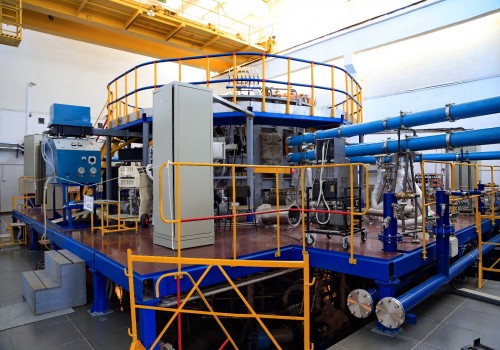Kazakhstan’s Contribution to the Human Mega-Project
27 July 2018

Kazakhstan’s Contribution to the Human Mega-Project
With the start-up of Kazakhstani Material Testing KTM, the task of creating and testing structural materials for the construction of fusion reactors will be completed.
Scientists of the National Nuclear Center of RK are working on the start-up of Tokamak KTM, one of the most important components of the International Mega-Project for the development of controlled ITER thermonuclear fusion.
In 1998, the President of Kazakhstan, Nursultan Nazarbayev, after a memorable meeting with the academician of the Russian Academy of Sciences, Velikhov, decided to create a unique facility at the territory of our Republic, which has no analogues in any country of the world. This is a Tokamak KTM designed to conduct studies of structural materials to be used in future power fusion reactors.
For 20 years, scientists of the National Nuclear Center of the Republic of Kazakhstan in Kurchatov have been working on the development of the Tokamak project. For example, it took several years, from 1998 to 2003, to develop the basic technical solutions, the feasibility study and the working project for the creation of Kazakhstani material testing bench complex. Only since 2003, the work of the construction site specially defined within Kurchatov was started.
For seven years, the project was funded by the Republican budget. And during that time, the facility of the material testing tokamak was actually assembled. However, for a variety of reasons, within 2010 to 2016, this unique facility was suspended in all respects for lack of funding.
The impetus for the resumption of construction and research work on the tokamak project was the preparation of Kazakhstan for the international "EXPO-2017" exhibition, where the first stage of physical start-up of Tokamak was planned to coincide with the opening ceremony of this huge international event. Thanks to the implementation of a joint program, specialists from NNC RK, the Kurchatov Institute and ROSATOM achieved this goal on July 9, 2017.
The first stage of the physical start-up included a complex of operations to debug and test the performance of KTM in-standard systems. Thus, the specialists of NNC performed the initial phase of the plasma discharge scenario: formation of the necessary conditions inside the vacuum chamber of the KTM with the arrangement of disruption.
“At present, start-up work is being completed at the Tokamak Complex. KTM facility is prepared for the final and second stage of the physical start-up, and the complex is ready to be commissioned”, - clarified Denis Zarva, Head of Investment Projects Department
“Tokamak KTM Material Testing Reactor is a highly sophisticated device that cannot be easily started-up” – clarified Erlan Batyrbekov, Director General of the National Nuclear Center of RK – “Tokamak – is a plasma, which is very capricious in its properties. It is very difficult for retention, it has very high temperatures. In addition, all these “caprices” our scientists have to overcome. Therefore, the physical start-up of tokamak is not as simple as the nuclear reactor start-up process”.
Despite this, as early as 2017, NNC RK concluded a number of favorable agreements with the International Thermonuclear Energy Organization, which also constructs Tokamak through the efforts of a number of countries. The First Experimental Demonstration Reactor (ITER-International Thermonuclear Experimental Reactor), based on controlled fusion and capable of generating power, is scheduled to be started-up in 2025 in Kadarash (France)”, - Denis Zarva informed.
According to experts, ITER project is currently being implemented by many countries of the world. In fact, it is one of the most expensive and technologically complex projects ever undertaken by humankind.
The interest in the work of Kazakhstani Material Testing Tokamak KTM is such that already on 2 June 2017, even before the official ceremony of the first stage of the physical start-up of the facility, the Agreement on Scientific and Technical Cooperation between NNC RK and ITER international organization.
A number of scientific and technical works are already being carried out under this agreement at the National Nuclear Centre of the Republic of Kazakhstan.
Moreover, a few days before the conclusion of the Agreement with ITER, on 26 May 2017, the Agreement was signed between the Governments of Kazakhstan, Belarus, Armenia, Kyrgyzstan, Tajikistan and the Russian Federation on the joint use of Tokamak KTM by CIS countries. This has made it possible to establish a legal and technical basis for broad cooperation among all interested CIS countries in the study of controlled fusion and related technologies.
At the same time, work on preparation of the KTM facility for physical start-up, development of material testing technologies, physical diagnostics and plasma physics and many other things is not stopped for a moment. All these researches are carried out within the framework of the NNC’s own program “KTM Science”.
“At present, one of the main issues in the construction of future fusion reactors is the construction and testing of their structural materials. This problem will be solved with the start-up of Kazakhstani Material Testing Tokamak KTM”, – Erlan Batyrbekov outlined the prospects for the application of the unique Kazakhstani facility. – “At the Tokamak, it is planned to test materials under heat load on them up to 20 MW per square meter, that corresponds to the energy load parameters for future fusion reactors. In addition, KTM research complex will address multiple engineering and fundamental scientific challenges. In the foreseeable future, thermonuclear reactors will provide humanity with an almost inexhaustible, environmentally friendly source of energy”.
Author: Yekaterina Gulyayeva, Semey
Source: https://www.kursiv.kz/thumb//fresh1532576245.pdf
Photo: from RSE NNC RK
Latest news by category:
-
Memorial Plaque Unveiled in Memory of Alexander Nikolayevich Kolbayenkov
02 December 2025
-
Young scientists from the National Nuclear Center of Kazakhstan recognized on the international stage
02 December 2025
-
Young specialists at the National Nuclear Center of Kazakhstan are among the best in the region!
01 December 2025
-
NNC RK and NAGRA Swiss Company Signed MoU on Radioactive Waste Management
01 December 2025